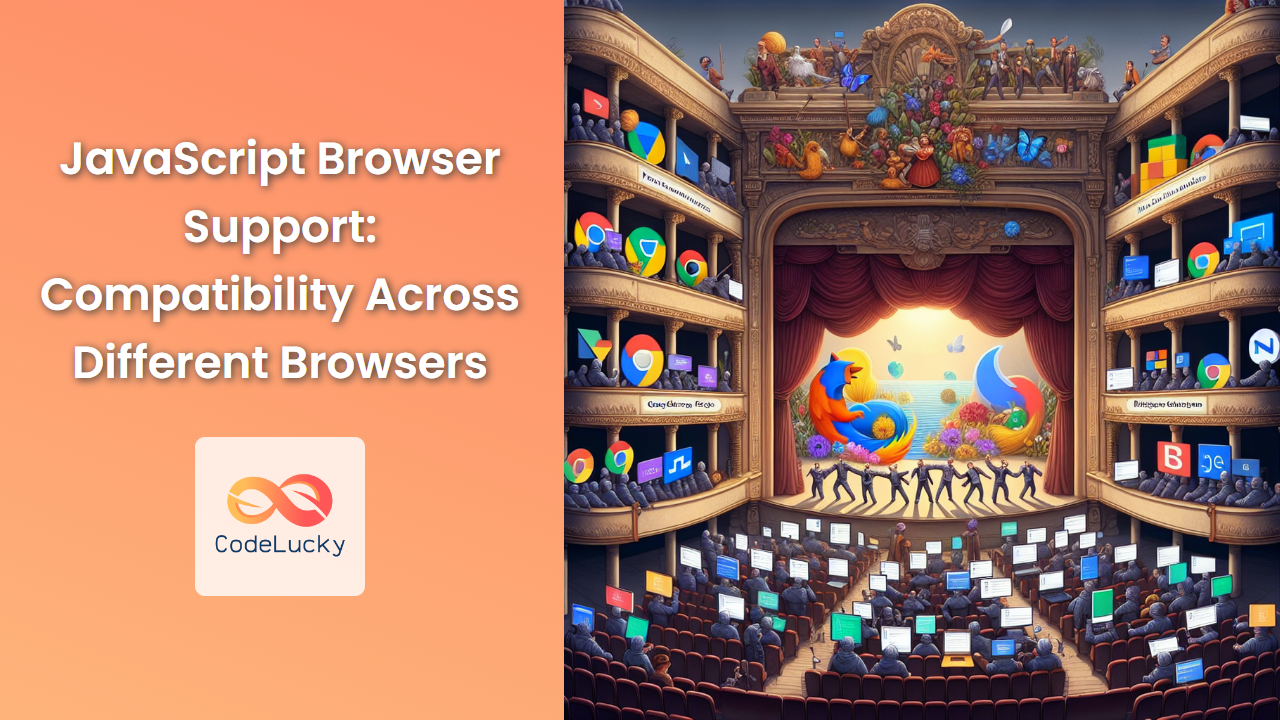JavaScript has become an integral part of web development, powering interactive and dynamic websites across the globe. However, as with any web technology, browser compatibility remains a crucial consideration for developers. In this comprehensive guide, we'll explore JavaScript browser support, delving into the intricacies of compatibility across different browsers and versions.
Understanding JavaScript Browser Support
JavaScript browser support refers to how well different web browsers interpret and execute JavaScript code. While the core language is standardized, browser implementations can vary, leading to inconsistencies in how JavaScript behaves across different platforms.
🔍 Key Point: Browser support is not just about whether a browser can run JavaScript, but how consistently it implements various features and APIs.
Let's dive into the specifics of JavaScript support across major browsers.
Major Browsers and Their JavaScript Engines
Before we discuss compatibility, it's essential to understand the JavaScript engines powering major browsers:
- Chrome: V8 Engine
- Firefox: SpiderMonkey
- Safari: JavaScriptCore (Nitro)
- Edge: Chakra (legacy), V8 (current)
- Opera: V8 (same as Chrome)
These engines interpret and execute JavaScript code, but they may have slight differences in implementation or performance.
JavaScript Feature Support Across Browsers
Let's examine some key JavaScript features and their support across different browsers:
1. ES6 (ECMAScript 2015) Features
ES6 introduced significant enhancements to JavaScript. Here's a breakdown of some key features and their support:
Arrow Functions
Arrow functions are widely supported in modern browsers. Let's look at an example:
// Arrow function
const greet = (name) => `Hello, ${name}!`;
console.log(greet('Alice')); // Output: Hello, Alice!
✅ Support: Chrome 45+, Firefox 22+, Safari 10+, Edge 12+, Opera 32+
let and const
Block-scoped variables declared with let and constants declared with const are crucial for modern JavaScript development:
let count = 0;
const MAX_COUNT = 10;
if (true) {
let count = 5; // Different variable, block-scoped
console.log(count); // Output: 5
}
console.log(count); // Output: 0
✅ Support: Chrome 49+, Firefox 44+, Safari 10+, Edge 14+, Opera 36+
Template Literals
Template literals allow for easier string interpolation and multiline strings:
const name = 'World';
const greeting = `Hello, ${name}!
This is a multiline string.`;
console.log(greeting);
// Output:
// Hello, World!
// This is a multiline string.
✅ Support: Chrome 41+, Firefox 34+, Safari 9+, Edge 12+, Opera 28+
2. Promises and Async/Await
Promises and the async/await syntax have revolutionized asynchronous programming in JavaScript:
function fetchData() {
return new Promise((resolve, reject) => {
setTimeout(() => resolve('Data fetched!'), 2000);
});
}
async function getData() {
try {
const result = await fetchData();
console.log(result);
} catch (error) {
console.error('Error:', error);
}
}
getData(); // Output after 2 seconds: Data fetched!
✅ Support for Promises: Chrome 32+, Firefox 29+, Safari 8+, Edge 12+, Opera 19+
✅ Support for Async/Await: Chrome 55+, Firefox 52+, Safari 10.1+, Edge 15+, Opera 42+
3. ES Modules
ES Modules provide a standardized way to organize and share JavaScript code:
// math.js
export function add(a, b) {
return a + b;
}
// main.js
import { add } from './math.js';
console.log(add(2, 3)); // Output: 5
To use ES Modules in HTML:
<script type="module" src="main.js"></script>
✅ Support: Chrome 61+, Firefox 60+, Safari 10.1+, Edge 16+, Opera 48+
4. Web APIs
Web APIs extend JavaScript's capabilities in the browser. Let's look at a few examples:
Fetch API
The Fetch API provides a powerful and flexible feature for making HTTP requests:
fetch('https://api.example.com/data')
.then(response => response.json())
.then(data => console.log(data))
.catch(error => console.error('Error:', error));
✅ Support: Chrome 42+, Firefox 39+, Safari 10.1+, Edge 14+, Opera 29+
LocalStorage API
LocalStorage allows for persistent data storage in the browser:
// Storing data
localStorage.setItem('username', 'Alice');
// Retrieving data
const username = localStorage.getItem('username');
console.log(username); // Output: Alice
// Removing data
localStorage.removeItem('username');
✅ Support: Chrome 4+, Firefox 3.5+, Safari 4+, Edge 8+, Opera 10.5+
Dealing with Browser Compatibility Issues
Despite widespread support for modern JavaScript features, developers still need to handle compatibility issues. Here are some strategies:
1. Feature Detection
Always use feature detection instead of browser detection. This approach checks if a feature is supported before using it:
if ('localStorage' in window) {
// Use localStorage
} else {
// Provide fallback or alternative
}
2. Polyfills
Polyfills are code snippets that provide modern functionality to older browsers. For example, a polyfill for the Array.prototype.includes method:
if (!Array.prototype.includes) {
Array.prototype.includes = function(searchElement, fromIndex) {
if (this == null) {
throw new TypeError('"this" is null or not defined');
}
var o = Object(this);
var len = o.length >>> 0;
if (len === 0) {
return false;
}
var n = fromIndex | 0;
var k = Math.max(n >= 0 ? n : len - Math.abs(n), 0);
while (k < len) {
if (o[k] === searchElement) {
return true;
}
k++;
}
return false;
};
}
3. Transpilation
Tools like Babel can transpile modern JavaScript code into older versions for broader browser support:
// Modern code
const greet = (name) => `Hello, ${name}!`;
// Transpiled for older browsers
var greet = function greet(name) {
return "Hello, " + name + "!";
};
4. Progressive Enhancement
Build your core functionality to work in all browsers, then enhance the experience for browsers that support more advanced features:
function submitForm() {
// Basic form submission logic
}
if ('fetch' in window) {
// Use Fetch API for enhanced, asynchronous form submission
submitForm = async function() {
// Advanced implementation using Fetch
};
}
Browser-Specific Quirks and Workarounds
Even with broad support for JavaScript features, some browser-specific issues may arise. Let's explore a few common quirks and their workarounds:
1. Event Handling Differences
Different browsers may have slight variations in event handling. For instance, the event object is implicitly passed in most browsers, but explicitly required in older versions of IE:
function handleClick(event) {
event = event || window.event; // Fallback for older IE
var target = event.target || event.srcElement; // Fallback for older IE
console.log('Clicked element:', target);
}
document.addEventListener('click', handleClick);
2. CSS Property Prefixes in JavaScript
When manipulating CSS properties via JavaScript, some properties may require vendor prefixes for full browser support:
function setTransform(element, value) {
element.style.webkitTransform = value; // For webkit browsers
element.style.mozTransform = value; // For Firefox
element.style.msTransform = value; // For IE/Edge
element.style.oTransform = value; // For Opera
element.style.transform = value; // Standard property
}
setTransform(document.getElementById('myElement'), 'rotate(45deg)');
3. Date Parsing Inconsistencies
Date parsing can be inconsistent across browsers. It's often safer to manually parse date strings or use a library like Moment.js:
// Inconsistent across browsers
const date1 = new Date('2023-06-15');
// More consistent manual parsing
const [year, month, day] = '2023-06-15'.split('-');
const date2 = new Date(year, month - 1, day);
console.log(date2); // Consistent output across browsers
4. XMLHttpRequest vs Fetch API
While the Fetch API is widely supported, you might need to provide a fallback for older browsers:
function request(url, callback) {
if ('fetch' in window) {
fetch(url)
.then(response => response.json())
.then(data => callback(null, data))
.catch(error => callback(error));
} else {
var xhr = new XMLHttpRequest();
xhr.open('GET', url, true);
xhr.onload = function() {
if (xhr.status === 200) {
callback(null, JSON.parse(xhr.responseText));
} else {
callback(new Error('Request failed'));
}
};
xhr.onerror = function() {
callback(new Error('Network error'));
};
xhr.send();
}
}
request('https://api.example.com/data', function(error, data) {
if (error) {
console.error('Error:', error);
} else {
console.log('Data:', data);
}
});
Testing for Browser Compatibility
Ensuring your JavaScript works across different browsers requires thorough testing. Here are some approaches:
1. Manual Testing
Test your website manually on different browsers and devices. This helps catch visual inconsistencies and interaction issues.
2. Automated Testing
Use tools like Selenium WebDriver or Puppeteer to automate browser testing:
const puppeteer = require('puppeteer');
(async () => {
const browser = await puppeteer.launch();
const page = await browser.newPage();
await page.goto('https://example.com');
// Test JavaScript functionality
const result = await page.evaluate(() => {
// Your test code here
return document.title;
});
console.log('Page title:', result);
await browser.close();
})();
3. Browser Stack or Sauce Labs
These services provide access to a wide range of browser versions and operating systems for comprehensive testing.
4. Feature Detection in Tests
Incorporate feature detection into your test suites:
describe('Modern JavaScript Features', () => {
it('should support arrow functions', () => {
expect(() => {
const arrowFunc = () => {};
}).not.toThrow();
});
it('should support Promises', () => {
expect(typeof Promise).toBe('function');
});
it('should support Fetch API', () => {
expect(typeof fetch).toBe('function');
});
});
Best Practices for Cross-Browser JavaScript Development
To ensure the best possible compatibility across browsers, follow these best practices:
-
Use Feature Detection: Always check for feature support before using it.
-
Provide Fallbacks: Offer alternatives for browsers that don't support certain features.
-
Use Transpilation and Polyfills: Leverage tools like Babel to write modern JavaScript that works in older browsers.
-
Test Extensively: Use a combination of manual and automated testing across multiple browsers and versions.
-
Stay Updated: Keep track of browser support for JavaScript features using resources like Can I Use.
-
Progressive Enhancement: Build a basic version that works everywhere, then enhance for modern browsers.
-
Use Standardized APIs: Prefer standard JavaScript and Web APIs over browser-specific implementations.
-
Validate Input: Don't assume all browsers will handle input consistently. Always validate and sanitize user input.
-
Performance Considerations: Be aware that some features may have performance implications in certain browsers.
-
Documentation: Clearly document any browser-specific code or known compatibility issues in your project.
Conclusion
JavaScript browser compatibility is a complex but crucial aspect of web development. By understanding the nuances of different browsers, leveraging modern tools and techniques, and following best practices, you can create robust, cross-browser compatible JavaScript applications.
Remember, the web is an ever-evolving platform. Stay informed about the latest developments in JavaScript and browser technologies to ensure your skills and applications remain current and effective.
Happy coding, and may your JavaScript run smoothly across all browsers! 🚀🌐



















